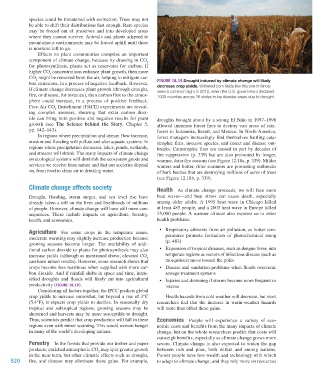Page 521 - Environment: The Science Behind the Stories
P. 521
species could be threatened with extinction. Trees may not
be able to shift their distributions fast enough. Rare species
may be forced out of preserves and into developed areas
where they cannot survive. Animals and plants adapted to
mountainous environments may be forced uphill until there
is nowhere left to go.
Effects on plant communities comprise an important
component of climate change, because by drawing in CO
2
for photosynthesis, plants act as reservoirs for carbon. If
higher CO concentrations enhance plant growth, then more
2
CO might be removed from the air, helping to mitigate car-
2
bon emissions, in a process of negative feedback. However, Figure 18.19 Drought induced by climate change will likely
decrease crop yields. Withered corn fields like this one in Illinois
if climate change decreases plant growth (through drought, were a common sight in 2012, when the U.S. government declared
fire, or disease, for instance), then carbon flux to the atmos- 1000 counties across 26 states to be disaster areas due to drought.
phere could increase, in a process of positive feedback.
Free-Air CO Enrichment (FACE) experiments are reveal-
2
ing complex answers, showing that extra carbon diox-
ide can bring both positive and negative results for plant droughts brought about by a strong El Niño in 1997–1998
growth (see The Science behind the Story, Chapter 5, allowed immense forest fires to destroy vast areas of rain-
pp. 142–143). forest in Indonesia, Brazil, and Mexico. In North America,
In regions where precipitation and stream flow increase, forest managers increasingly find themselves battling cata-
erosion and flooding will pollute and alter aquatic systems. In strophic fires, invasive species, and insect and disease out-
regions where precipitation decreases, lakes, ponds, wetlands, breaks. Catastrophic fires are caused in part by decades of
and streams will shrink. The many impacts of climate change fire suppression (p. 339) but are also promoted by longer,
on ecological systems will diminish the ecosystem goods and warmer, drier fire seasons (see Figure 12.18a, p. 339). Milder
services we receive from nature and that our societies depend winters and hotter, drier summers are promoting outbreaks
on, from food to clean air to drinking water. of bark beetles that are destroying millions of acres of trees
(see Figure 12.18b, p. 339).
Climate change affects society Health As climate change proceeds, we will face more
Drought, flooding, storm surges, and sea level rise have heat waves—and heat stress can cause death, especially
already taken a toll on the lives and livelihoods of millions among older adults. A 1995 heat wave in Chicago killed
of people. However, climate change will have still more con- at least 485 people, and a 2003 heat wave in Europe killed
sequences. These include impacts on agriculture, forestry, 35,000 people. A warmer climate also exposes us to other
health, and economics. health problems:
• Respiratory ailments from air pollution, as hotter tem-
Agriculture For some crops in the temperate zones, peratures promote formation of photochemical smog
moderate warming may slightly increase production because (p. 483)
growing seasons become longer. The availability of addi-
tional carbon dioxide to plants for photosynthesis may also • Expansion of tropical diseases, such as dengue fever, into
increase yields (although as mentioned above, elevated CO temperate regions as vectors of infectious disease (such as
2
can have mixed results). However, some research shows that mosquitoes) move toward the poles
crops become less nutritious when supplied with more car- • Disease and sanitation problems when floods overcome
bon dioxide. And if rainfall shifts in space and time, inten- sewage treatment systems
sified droughts and floods will likely cut into agricultural • Injuries and drowning if storms become more frequent or
productivity (Figure 18.19). intense
Considering all factors together, the IPCC predicts global
crop yields to increase somewhat, but beyond a rise of 3°C Health hazards from cold weather will decrease, but most
(5.4°F), it expects crop yields to decline. In seasonally dry researchers feel that the increase in warm-weather hazards
tropical and subtropical regions, growing seasons may be will more than offset these gains.
shortened and harvests may be more susceptible to drought.
Thus, scientists predict that crop production will fall in these Economics People will experience a variety of eco-
regions even with minor warming. This would worsen hunger nomic costs and benefits from the many impacts of climate
in many of the world’s developing nations. change, but on the whole researchers predict that costs will
outweigh benefits, especially as climate change grows more
Forestry In the forests that provide our timber and paper severe. Climate change is also expected to widen the gap
products, enriched atmospheric CO may spur greater growth between rich and poor, both within and among nations.
2
in the near term, but other climatic effects such as drought, Poorer people have less wealth and technology with which
520 fire, and disease may eliminate these gains. For example, to adapt to climate change, and they rely more on resources
M18_WITH7428_05_SE_C18.indd 520 12/12/14 4:05 PM

